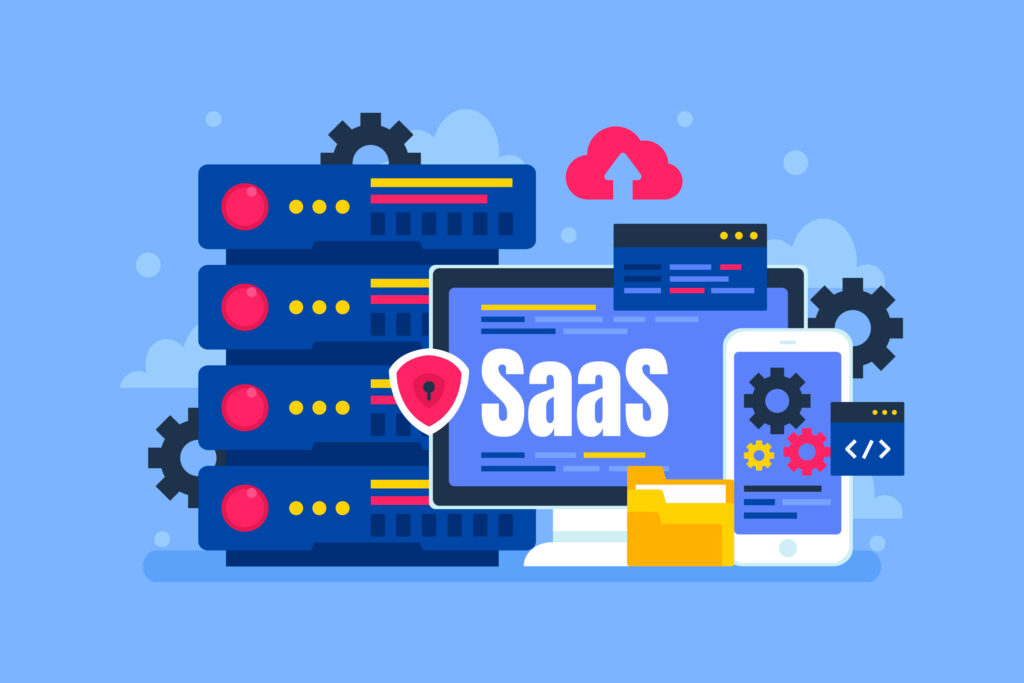Vertical SaaS Vs Horizontal SaaS: What a SaaS Buyer Should Know?

Vertical SaaS or Horizontal SaaS? It’s not just tech buzzwords – it’s the million-dollar question for smart businesses today. Imagine picking software that fits your company like a glove versus one that’s a jack-of-all-trades. Curious? You should be. The right choice could skyrocket your efficiency or leave you trailing behind. Ready to unlock the secret sauce of SaaS selection? Let’s get started!
What is Vertical SaaS?
Vertical SaaS refers to industry-specific software solutions designed to meet the unique needs of a particular sector or niche market. These platforms offer specialized features, workflows, and tools tailored to the specific requirements of businesses within a single industry.
Key characteristics of Vertical SaaS include:
- Industry-specific functionality
- Customized terminology and processes
- Built-in compliance with industry regulations
- Targeted data analytics and reporting
- Streamlined workflows for specific business processes
Examples of Vertical SaaS include:
- Healthcare management systems for hospitals
- Property management software for real estate companies
- Restaurant management platforms for the food service industry
Vertical SaaS solutions aim to provide more value to their target market by offering deep, industry-specific features rather than broad, general-purpose tools.
What is Horizontal SaaS?
Horizontal SaaS refers to software solutions designed to serve a wide range of industries and business types. These platforms offer general-purpose functionality that can be applied across various sectors, addressing common business needs.
Key characteristics of Horizontal SaaS include:
- Broad applicability across industries
- General business functions and processes
- Flexible customization options
- Wide range of integrations
- Scalability for businesses of different sizes
Examples of Horizontal SaaS include:
- Customer Relationship Management (CRM) systems
- Human Resources Management software
- Project management tools
- Accounting and financial software
- Communication and collaboration platforms
Horizontal SaaS solutions aim to provide versatile tools that can benefit a diverse array of businesses, focusing on common needs rather than industry-specific requirements.

Comparison Between Vertical SaaS and Horizontal SaaS
Target Markets and Industries
Vertical SaaS:
- Focuses on specific industries or niches (e.g., healthcare, finance, legal).
- Targets businesses with specialized needs and workflows.
- Offers deep industry knowledge and tailored solutions.
Horizontal SaaS:
- Targets a broad range of industries and business sizes.
- Provides generic solutions applicable across different sectors.
- Offers a wider potential customer base.
Customization and Flexibility
Vertical SaaS:
- Offers higher levels of customization aligned with industry-specific requirements.
- Provides pre-built integrations and workflows tailored to the target market.
- May have limited flexibility for businesses outside the target industry.
Horizontal SaaS:
- Offers greater flexibility to adapt to various business needs and processes.
- Requires more customization efforts to fit specific industry requirements.
- Provides a broader range of configuration options.
Scalability and Integration Capabilities
Vertical SaaS:
- Often scales well within the target industry but may face challenges in expanding to new markets.
- Integrates seamlessly with industry-specific tools and systems.
Horizontal SaaS:
- Typically offers better scalability across different industries and business sizes.
- Provides a wider range of integration options due to its broader focus.
Pricing Models
Vertical SaaS:
- May have premium pricing due to higher development and customization costs.
- Often offers tiered pricing based on specific industry features and user roles.
Horizontal SaaS:
- Typically offers more competitive pricing due to a larger customer base.
- May have usage-based or subscription-based pricing models.
Popular SaaS Pricing Models: What Every Software Buyer Should Know
Implementation and Onboarding Processes
Vertical SaaS:
- Often has streamlined implementation and onboarding processes tailored to the industry.
- Provides industry-specific training and support resources.
Horizontal SaaS:
- May require more customization and configuration during implementation.
- Offers general onboarding and training materials applicable to various industries.
Carefully evaluating these factors will help you select the best solution for your business.
Benefits of Vertical SaaS
Vertical SaaS delivers significant benefits by focusing on industry-specific challenges and requirements, creating a competitive advantage and driving growth for both businesses and customers.
For Businesses:
- Higher Conversion Rates: Targeting specific industries leads to more relevant marketing and better conversions.
- Lower Customer Acquisition Cost (CAC): Optimized strategies for a clear target market reduce acquisition costs.
- Less Competition: Focusing on a niche often means facing less competition.
- Lower Customer Churn: Tailored solutions and deep industry knowledge increase customer satisfaction and retention.
- Higher Growth Potential: Becoming an industry leader in a specific vertical can drive significant growth.
For Customers:
- Specialized Solutions: Offers solutions that match specific industry needs, increasing efficiency and productivity.
- Improved Functionality: Tailored features address industry challenges effectively.
- Cost Savings: Streamlines operations and reduces the need for custom software development.
- Enhanced Compliance: Industry-specific regulations are often integrated, ensuring compliance.
- Better User Experience: Designed for specific industries, offering a more intuitive interface and workflow.
Benefits of Horizontal SaaS
Horizontal SaaS solutions cater to a broad spectrum of industries, offering generic tools and functionalities that can be adapted to various business needs. This approach offers several advantages:
For Businesses
- Wide Applicability: Can be used across different departments and functions within an organization.
- Cost-Effective: Economies of scale often lead to lower pricing compared to vertical SaaS.
- Faster Implementation: Generally quicker to set up due to its generic nature.
- Larger User Base: Benefits from a larger community and more available resources.
- Flexibility: Can be adapted to various business processes and workflows.
For Customers:
- Wide Applicability: Usable across various industries and business sizes, offering flexibility and adaptability.
- Cost-Effective: Larger customer base allows for more competitive pricing.
- Quick Implementation: Faster setup time with less need for extensive customization.
- Large User Base: More resources like tutorials, forums, and support available.
- Scalability: Designed to accommodate growth without needing to switch platforms.
- Integration Capabilities: Seamless integration with other business applications.
- Focus on Core Functions: Manages essential business processes, allowing businesses to concentrate on their core competencies.
Current Trends in Vertical SaaS vs Horizontal SaaS
The SaaS landscape is rapidly evolving, with distinct trends favoring both Vertical and Horizontal SaaS models. Let’s delve into the current dynamics:
Vertical SaaS: Deepening Specialization and Industry Focus
- Niche Dominance: Providers focus on specific industry segments with highly tailored solutions, understanding customer pain points better.
- AI and Automation: Integration of AI and automation enhances efficiency by automating tasks and improving decision-making.
- Data-Driven Insights: Leveraging data analytics helps identify opportunities, optimize offerings, and improve customer experiences.
- Ecosystem Development: Building ecosystems with complementary partners creates a comprehensive value proposition.
Horizontal SaaS: Expanding Functionality and Integration
- Platformization: Platforms become open ecosystems for easy integration with other applications.
- Hyper-Personalization: AI and machine learning enable more personalized solutions for individual needs.
- Low-Code/No-Code Development: Users can customize and extend functionality without extensive coding.
- Subscription Bundling: Offering bundled subscriptions increases customer value and solution comprehensiveness.
Key Trends Impacting Both Models
- Cloud-Native Architecture: Both adopt cloud-native approaches for scalability, agility, and cost-efficiency.
- Cybersecurity: Investment in cybersecurity measures to protect customer data is crucial.
- Customer Experience: Focus on exceptional support, user-friendly interfaces, and continuous improvement.
- Subscription Economics: Optimizing subscription models and understanding customer lifetime value are critical.
The Future of SaaS
The future of SaaS will likely witness a hybrid approach, with vertical SaaS solutions addressing specific industry needs and horizontal SaaS providing core business functionalities. Collaboration between these two models will create more comprehensive and effective software solutions. Learn How SaaS Solutions Accelerate Digital Transformation in Modern Businesses
How to Choose Between Vertical and Horizontal SaaS
The decision between vertical and horizontal SaaS is crucial for optimizing operations and gaining a competitive edge. Here are the key factors to consider:
Conducting a Needs Analysis
- Identify Core Business Processes: Determine areas where software can enhance efficiency and productivity.
- Assess Pain Points: Identify challenges and how software can address them.
- Evaluate Scalability: Consider if the software can adapt to future growth.
- Compliance Requirements: Check if industry regulations necessitate a vertical solution.
Evaluating Pros and Cons for Your Specific Business
Vertical SaaS:
- Pros: Tailored solutions, deep industry expertise, faster implementation, reduced customization needs.
- Cons: Limited flexibility, potentially higher costs, vendor lock-in, reliance on vendor for updates.
Horizontal SaaS:
- Pros: Cost-effective, flexibility, scalability, broader feature set.
- Cons: Requires customization, potential for feature bloat, steeper learning curve, integration challenges.
Considering Hybrid Approaches
- Best-of-Both Worlds: Integrate vertical and horizontal solutions to leverage the strengths of both models.
- Core Functionality: Use horizontal platforms for general business processes.
- Specialized Needs: Employ vertical solutions for industry-specific requirements.
Importance of Trials and Demos
- Hands-On Experience: Test software performance and usability.
- Data-Driven Decisions: Gather insights into user adoption and productivity.
- Risk Mitigation: Identify potential issues before committing to a long-term contract.
Involving Stakeholders in the Decision-Making Process
- Diverse Perspectives: Include input from various departments and roles.
- Shared Ownership: Foster commitment to the chosen solution.
- Effective Implementation: Ensure alignment between software and business goals.
Key Considerations:
- Business Size: Smaller businesses might benefit from vertical SaaS, while larger enterprises may prefer horizontal solutions.
- Industry Maturity: Established industries with defined processes often have mature vertical SaaS options.
- Budget: Vertical SaaS can be more expensive but may offer a faster return on investment.
- IT Resources: Horizontal SaaS generally requires more IT involvement for customization and integration.
By carefully evaluating these factors and involving key stakeholders, you can make an informed decision that aligns with your business objectives and drives long-term success.
Also read Buying Software: Essential Tips for Evaluating and Selecting Software






